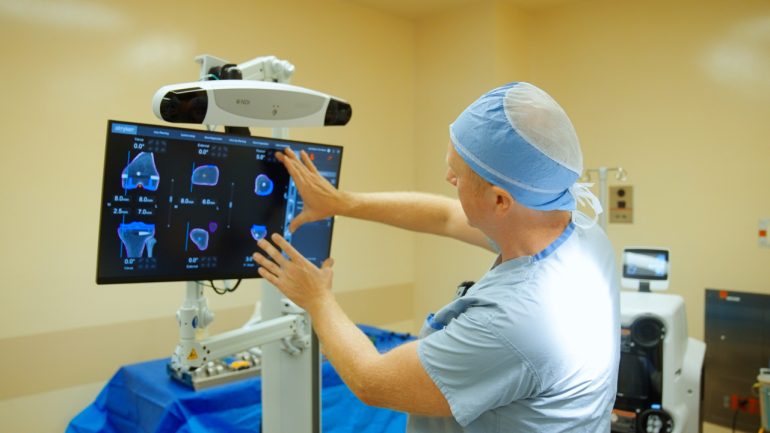To provide the best surgical care for patients, Burnaby Hospital Foundation and Fraser Health partnered on a $2.3 million robotic-assisted surgical system for the Jim Pattison Surgery Centre at Burnaby Hospital. The Mako Robotic-Arm Assisted System allows surgical teams to perform hip and knee replacement surgery with greater precision and accuracy.
Since June 3, 2024, more than 50 patients have received full or partial robotic-assisted knee replacement surgery. “It’s going very well,” says Dr. Tim Kostamo, division head, Orthopedics, Burnaby Hospital, and Burnaby Hospital Foundation Board Member. “Patients are recovering well. We’ve had no complications, and our early review shows perfectly aligned and balanced knees.”
While the robotic arm is an impressive piece of technology, it couldn’t do what it does without the accompanying system that creates pre-operative plans using CT imaging and software. As part of the pre-planning process, every patient has a CT scan that produces an individualized 3D model of their joint, including details like deformities and degree of arthritis. Armed with the intricacies of each patient’s joint, the surgeon then uses software that controls the robotics to plan precise cuts to the bone. “The robot can exactly match the CT scan,” says Dr. Kostamo, “making it possible for the implant to be completely dialed in to the patient’s anatomy.”
More precision in the surgical process is expected to result in quicker recovery times for patients, fewer complications, and less post-operative pain. A quality improvement review is underway, and the research will be presented at an Orthopedics conference in early 2025.
While the goal is improved patient care, the benefits extend beyond the patient. “Surgery is incredibly demanding — both in terms of stress and physical exertion,” says Dr. Kostamo. “This robotic arm aids the surgeon for a very physically demanding part of the operation. It helps them conserve energy and thus increase their ability to perform more procedures.”
Three surgeons are now trained on the Mako system. The target is 350 Mako cases annually, representing about half of all hip and knee replacement cases at Burnaby Hospital.



